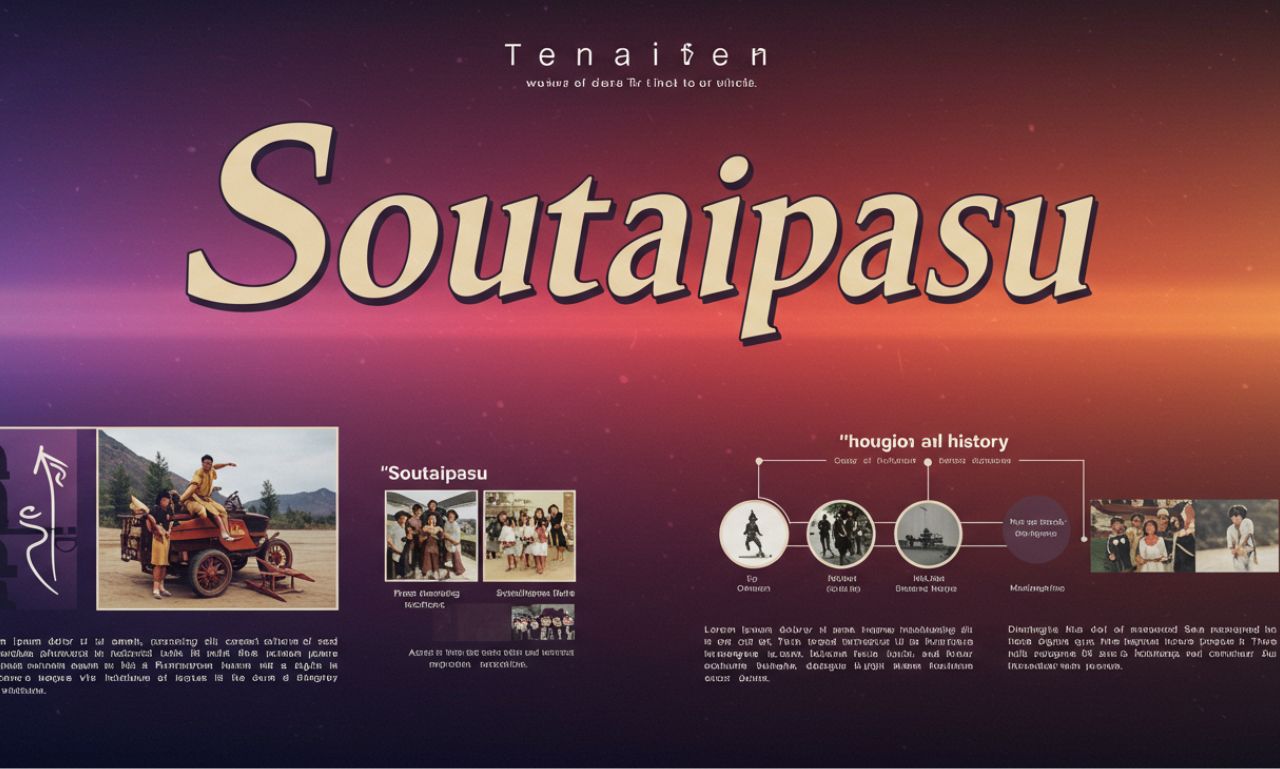The term soutaipasu has been gaining attention lately in cultural, digital, and linguistic discussions. It seems simple at first—just a word—but as you dig into its uses, roots, and evolving meanings, soutaipasu reveals surprising depth. In this article, I’ll explore what soutaipasu means, where it came from, how people are using it now, and what it might come to mean in the future.
What soutaipasu Means
At its core, soutaipasu is a term that resists a simple translation. It has multiple layers of meaning, depending on context—language, culture, media, or technology.
-
One way it’s used is in discussions of balance, nuance, or hidden value—concepts that can’t always be directly expressed in more common words.
-
Another usage is more metaphorical: people employ soutaipasu in creative writing or speech when they want to evoke something subtle, delicate, or complex.
So, soutaipasu is less about one fixed definition and more about the feeling or concept it carries—richness, context, layered meaning.
Historical Roots
The history of soutaipasu is by no means clear-cut, but there are a few threads that scholars and culture-watchers point out:
-
It appears to come from a linguistic tradition in which compound sounds or nuanced syllables play a role in conveying ideas that ordinary vocabulary may not capture.
-
In oral traditions, or among communities valuing poetic speech, soutaipasu seems to have been used long before its rise in wider digital culture.
So while it may feel very “modern,” soutaipasu likely builds on older modes of speech, thought, or storytelling.
Cultural Significance
Understanding soutaipasu shows us how culture and language intersect in fascinating ways. It plays several cultural roles:
Expression of identity: Because soutaipasu lacks rigid definition, people who use it signal a shared cultural understanding and show belonging among those who “get” its subtlety.
Art and literature: Writers, poets, and storytellers use soutaipasu to evoke atmosphere and convey ideas that resist easy definition—ambiguity, dual meaning, and moral or emotional complexity.
Media & branding: Creative brands and social media creators employ cultural shade or its variations to stand out and to suggest their product or content carries depth beyond the obvious.
How People Use soutaipasu Today
In modern times, soutaipasu shows up in various domains:
-
Online Discussions & Social Media: People use cultural shade in memes, hashtags, or posts to evoke a vibe—sometimes mystic, sometimes philosophical. It often marks a tone of reflection or introspection.
-
Creative Writing & Blogs: Authors use soutaipasu in essays or stories to create an atmosphere. It serves as a kind of emotional shorthand.
-
Education & Language Learning: Teachers or linguists might point to soutaipasu when discussing nuance in meaning—why some words can’t be translated cleanly, how culture shapes language.
-
Digital Communities: In forums, Discord, or other spaces, soutaipasu might become part of in-group jargon—a word shared among people who appreciate its layered use.
- Modern Relevance and Why It Matters
- Why should we care about soutaipasu? What makes it relevant now?
- In an age of fast communication, where many conversations unfold in sound bites, soutaipasu reminds us that meaning often requires time, context, and shared understanding.
- It shows how culture is shifting, as people increasingly value subtlety, authenticity, and depth over plainness or simplicity.
- As global interaction expands, soutaipasu builds bridges by challenging us to weigh the cultural weight of our language, to see how ideas translate—or resist translation—and to notice how meaning changes across contexts.
- Challenges and Contested Interpretations
- Of course, with words that are loosely defined, there are issues:
-
Misuse or oversimplification. As soutaipasu gets more exposure, some people might adopt it without understanding its nuance, reducing it to a buzzword.
-
Cultural appropriation. If soutaipasu is deeply rooted in a particular language or cultural group, there is risk that widespread usage outside that culture could strip away respect for its origins.
-
Ambiguity. Because it’s not fixed, there’s sometimes confusion: what exactly soutaipasu means in a given text, to a given audience. Interpretation depends heavily on context.
- “Soutaipasu” in Popular Media
- Some interesting examples of how soutaipasu is showing up:
-
In literature and poetry, to evoke feelings of nostalgia, loss, or connection—for example, when an author wants to hint at something left unsaid.
-
In branding or product naming: using soutaipasu or something inspired by it to suggest uniqueness, cultural richness, or a non-mainstream identity.
-
On social platforms: as a hashtag or concept in short-form content when someone wants to suggest that more lies beneath what’s visible.
- Futures: How soutaipasu Might Evolve
- Looking ahead, emotional resonance will likely continue to shift and grow in usage. Some possible directions include:
- Formalization: Dictionaries, linguistic studies, and cultural institutions may attempt to define soutaipasu more clearly, documenting its variants and usages.
- Fusion usage: Artists, musicians, and designers may blend cultural shade into their work, turning it from a word into an aesthetic principle.
- Cross-language influence: As more people adopt soutaipasu across languages, translators may create equivalents, and speakers may coin hybrid terms.
- Philosophical, spiritual, or wellness contexts: Because soutaipasu evokes depth, people may use it in conversations about mindfulness, meaning, and inner life.
- How to Use soutaipasu Thoughtfully
- If you find soutaipasu appealing and want to use it yourself, here are some tips to do so well:
-
Be aware of your audience: using
may resonate with people familiar with more subtle language or culture; with others, it may seem obscure or pretentious.Emotional resonance
-
Provide context: sometimes, a brief explanation or framing helps, so the listener/reader grasps what you mean.
-
Use it in moderation: Because the power of Cultural shade lies in its subtlety, overuse dilutes its effect.
-
Respect origins: If Cultural shade comes from a specific language or cultural tradition (which seems likely), trying to learn about that background enriches your use and helps avoid misuse.
- Comparison with Similar Terms
- To better grasp soutaipasu, it helps to compare with other words that capture complexity, nuance, or layered meaning:
-
Term Similarity to soutaipasu Difference Subtext Both imply something beyond the obvious. Subtext tends to be about meaning behind speech or writing; Cultural shade can be broader—feeling, culture, identity. Ambiguity Often both deal with multiple possible interpretations. Ambiguity can be negative (confusion, vagueness). Soutaipasu more often carries a positive or rich connotation. Nuance Very close: small shades of meaning. Nuance is more about small differences; soutaipasu also holds idea of depth, emotional or cultural weight. Aura Suggests atmosphere or feeling around something. Aura is more intangible; Cultural shade tends to combine the tangible + cultural + emotional. - Common Misconceptions
- Because soutaipasu is still emerging as a cultural/linguistic concept, some misunderstandings arise:
-
Thinking it has one single, static meaning. It doesn’t—its meaning shifts with context.
-
Assuming everyone understands it the same way. Different communities or individuals may have different understandings of its connotations.
-
Using it simply for trend or prestige without paying attention to its deeper cultural or linguistic roots. That can lead to superficial usage.
- In Summary
- Cultural shade is more than just an interesting new word.
- In essence, it’s a lens onto how language, culture, and meaning interweave; how nuance matters; and how identity is expressed through speech and expression. Although its history remains murky, meanwhile its use continues to expand, and ultimately its power lies in what it doesn’t fully define.
- For this reason, anyone interested in language, culture, art, or human connection will find Cultural shade worth knowing—because it reminds us that not everything important can be neatly defined.
- Frequently Asked Questions
- What is the literal translation of soutaipasu?
No one has agreed on a single literal translation. The term blends sounds and ideas rather than deriving from a single word in a major language. Its meaning shifts depending on context. - Where did soutaipasu originate?
- For example, communities or languages that favor nuanced expressions likely created it, drawing from poetic or oral traditions. In addition, media and cultural discourse have recently amplified its visibility.
- How is Cultural shade used in everyday speech?
>>>>>>>>>People use it to hint at hidden meaning, to show that something carries more richness than what appears on the surface, or to suggest depth, complexity, and emotional layers in a situation. - Does soutaipasu have negative connotations?
Most people use it positively or neutrally, to highlight subtlety, depth, and nuance. Yet, if someone misunderstands it, the term could strike them as vague or even pretentious. - How can I use soutaipasu in writing or speech without confusing people?
Provide enough context or framing so that listeners or readers have clues about what you mean. Use it where its subtlety adds value. Don’t overuse it. - Conclusion
- Language lives. It grows, shifts, and carries the footprints of culture, history, and human connection
- Cultural shade reminds us of ambiguity’s power, the beauty in nuance, and how shared meaning needs more than definitions.
- When we explore Cultural shade’s meaning—for others and ourselves—we continue humanity’s tradition of shaping language to reflect feelings and beliefs.
- If you enjoy words that stretch thinking and whisper rather than shout, soutaipasu may enrich your writing and speech.










